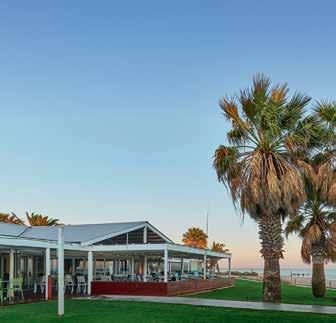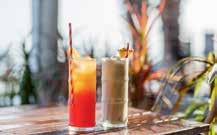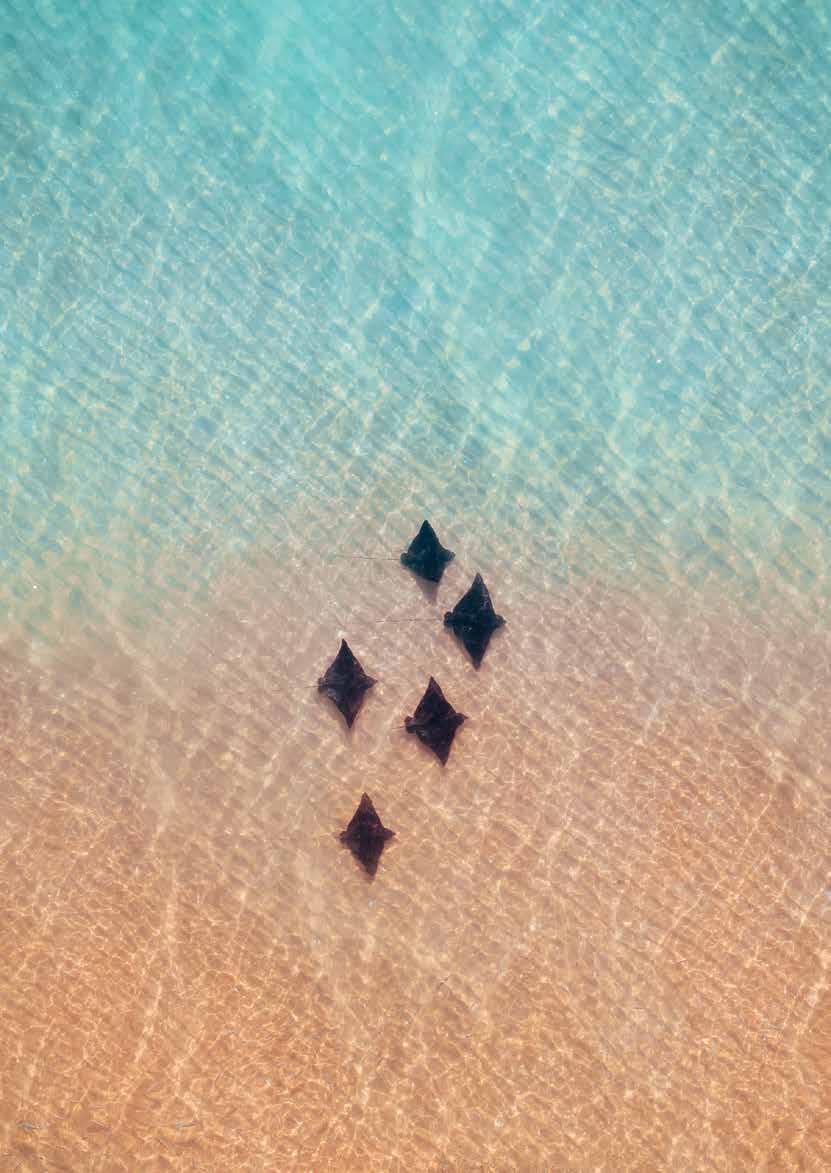




RAC members enjoy exclusive rates.

RAC Parks & Resorts

Discover the freedom to experience Shark Bay’s natural wonders, where ancient landscapes meet turquoise waters rich with marine life. Take only memories, leave only footprints.

Shark Bay World Heritage Discovery & Visitor Centre
Accommodation | Tour Bookings Quality Gifts | Gallery | Museum
53 Knight Terrace, Denham Ph: (08) 9948 1590
sbdc@sharkbay.wa.gov.au sharkbayvisit.com.au
Published by Vanguard Publishing
Printed by Vanguard Print
Distributed by Vanguard Distribution
Sales Director: Natalie Du Preez natalie@vanguardpublishing.com.au
Shark Bay is the traditional home of the Malgana People. Gathaagudu is the Malgana peoples’ name for Shark Bay, meaning “Two Waters“ because of the two protected bays within this ancient and spectacular landscape. We would like to acknowledge the Malgana Peoples as the traditional custodians of the land and sea in and around the Shire of Shark Bay. We pay our respects to their Elders past, present and emerging.
Designer: Karen Morton
Vanguard Media Group
26 John Street, Northbridge WA 6003
Ph: 08 6323 1389 vanguardmediagroup.com.au
Published 2025. All information in this brochure is correct at the time of publication. Cover image: Skipjack Point CJ Maddock
Come on a remarkable journey through unique country, immerse yourself in the cultural experience and discover the pristine natural features of Shark Bay.
A wonderland of world-class natural attractions, the Shark Bay World Heritage Area was the first location in Western Australia to receive UNESCO status in 1991. The area meets four of the ten potential natural criteria and remains one of only a handful of places in the world to achieve this high criteria status level. The colourful and diverse landscapes, rare flora and fauna and world-class examples of Earth’s ecological processes all contribute to the region being World Heritage listed.
Plan to spend time exploring the natural beauty of the bays, inlets and islands, and discovering rare plants, mammals and birds found only in this area. Choose from 4WD tours, sailing cruises, fishing charters, scuba diving and scenic flights, or just take time out to soak up the warm beaches and clear waters.
To find out more about Shark Bay’s World Heritage status, visit the Shark Bay World Heritage Discovery & Visitor Centre or visit sharkbayvisit.com.au

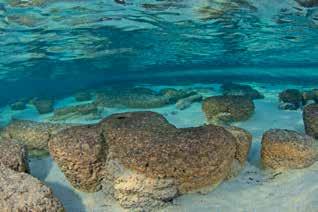

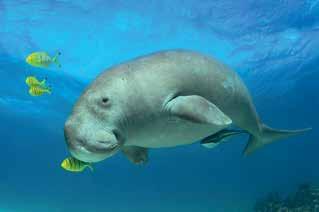
Shark Bay has five of Australia’s 26 species of
as well as 35% of all of Australia’s

1
Explore the breathtaking colours of Francois Peron National Park on the northern half of the Peron peninsula.

2
Up for a 4WD adventure?
Take a drive or book a tour to Edel Land National Park and visit the most westerly point of mainland Australia — Steep Point.
Enjoy the world famous Monkey Mia Dolphin Experience. Watch the daily dolphin experience from 7.45am at Monkey Mia Conservation Park and learn their fascinating history.
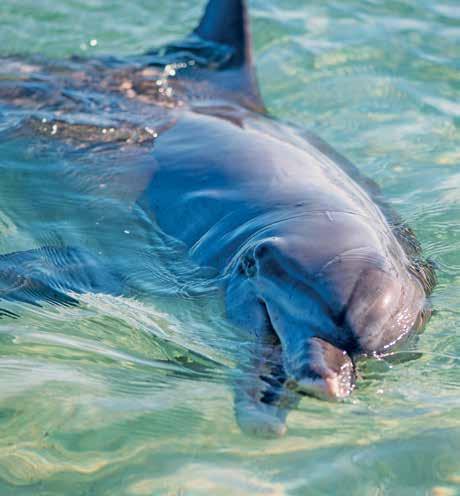
4
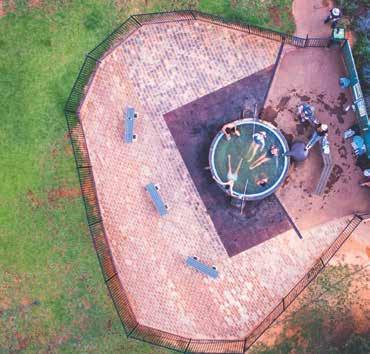
3
Soak in the artesian hot tub at the Peron Homestead. Make use of the free barbecue and stroll around the shearer’s quarters and interpretive centre.
Visit the Shark Bay World Heritage Discovery & Visitor Centre to learn more about this fascinating World Heritage Area and its vast history. Experience the art gallery, HMAS Sydney II memorial, Fire on the Water exhibit and 3D film.

5
Visit Dirk Hartog Island National Park — the longest island in Western Australia, offering stunning natural beauty and untamed wilderness.



Take a casual stroll around Little Lagoon and Lagoon Creek and make use of the free barbecue facilities. Swim, paddle board, kite surf or relax and watch the sunset.
Check out Shell Beach, made up solely of Hamelin cockle shells and one of only two beaches in the world of its kind. It stretches 60km with shells up to 10m deep! 6 9 7 8 10
Visit the Stromatolites at Hamelin Pool. These living fossils are over 3 billion years old. Best viewed at low tide from the beach. Stromatolite boardwalk is under maintenance.
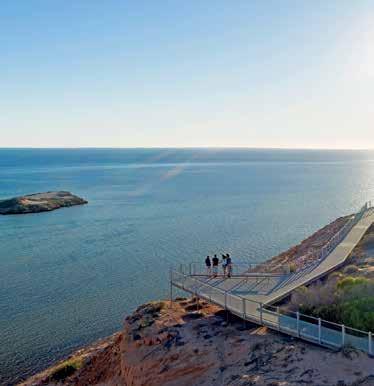
Walk along the boardwalk at Eagle Bluff lookout and try your luck at spotting sharks, rays, turtles and many more marine species.

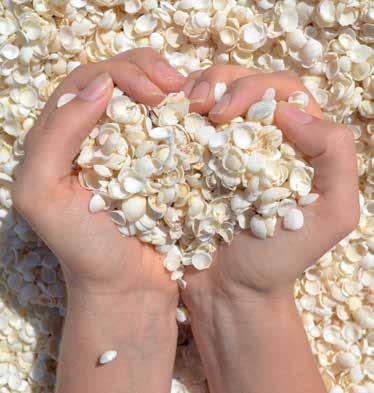
Set against the backdrop of one of Australia’s most breathtaking coastal landscapes, Denham is a laid-back seaside town and the perfect base to explore the wonders of Shark Bay — a UNESCO World Heritage-listed area. Whether you're an adventurer, nature lover, family traveller, or simply in need of a peaceful escape, Denham has something special for you.
Start your day with a stroll along Denham’s stunning foreshore, where turquoise waters meet white sand, and palm trees line the walking paths. Let the kids run wild at the adventure park playground, or head straight to the calm bay for a morning paddle on a stand-up board. Feeling bold? Join the locals and jump off the jetty into the refreshing water.
For those who prefer a slower pace, bring a book, practice yoga by the shore, or simply soak up the sun with your feet in the sand. Free picnic and BBQ facilities make it easy to enjoy a relaxed outdoor lunch – or if you’re in the mood for something hot and easy, grab takeaway from one of Denham’s cafés, bakeries, or pubs and enjoy your meal with a frontrow view of the ocean.




Delve into the rich culture and natural history of the region at the Shark Bay World Heritage Discovery & Visitor Centre, home to an immersive museum, local art gallery, and an information hub staffed by friendly, knowledgeable locals ready to help you make the most of your visit. For a deeper connection to Denham’s heritage, follow the Denham Discovery Trail , a self-guided walk that reveals the town’s fascinating past through interpretive signs and historic landmarks.
As the sun dips low on the horizon, find your spot on the foreshore and prepare

for one of the most spectacular sunsets in Western Australia – where the sky bursts into brilliant hues of orange, pink, and gold. It’s the perfect time to unwind, reflect, and feel the simple magic of coastal life.
Before you leave, don’t forget to explore local shops offering handcrafted souvenirs, artworks, and Shark Bayinspired gifts – unique keepsakes made with love by the community.
In Denham, every day brings a new opportunity to relax, explore, and reconnect with nature.


Swimming
Shark
Shark
Post Office & Gift Shop
Visitor Information Centre
Dept. of Biodiversity, Conservation & Attractions
Shire of Shark Bay
Pearls and Shells Hair Design
Pharmacy
Aristocrat 2 Office
Shoreline Dive and Coffee
Blue Lagoon Pearls
Ray White Real Estate
The Old Pearler Restaurant
The Heritage Resort
Wildsights Villas
Shark Bay Fuel & Fishing
Shark Bay Bakery
Cellarbrations
Shark Bay Pizzas
Shark Bay Seafront Apartments
IGA
Renowned as one of the best and most reliable places for dolphin interactions in the world, Monkey Mia is a must see for families and nature lovers alike. Three generations of bottlenose dolphins have been visiting the beach each day for 40 years, to the delight of visitors from all over the world.

Learn more about the dolphins at the Monkey Mia Visitor Centre
Spot a dugong (sea cow) on one of the popular wildlife watching cruises
Hire a kayak or paddle board and experience Monkey Mia from the water.
An excellent way to explore the local landscape of Monkey Mia is to join Wulyibidi Yanayina walking trail which starts at the Monkey Mia car park and winds through surrounding red sand dunes. The trail includes a bird hide by a water hole and a section of beautiful coastline.
Distance: 3km loop. Time: 1-1.5 hours.
Dolphins are very curious. For their well-being and your safety, please do not touch or swim with the dolphins.
The dolphins are wild animals that visit the beach of their own free will. Dolphin experiences depend entirely on if and when the dolphins visit the beach between 7.45am and 12 noon. The best time to arrive is 7.45am. Be sure to arrive on time as the three experiences can be over as early as 9am some mornings. The experience can be less crowded if the dolphins return later in the morning. The rangers offer the dolphins small amounts of fish during the morning, but the exact times are all dependent on the dolphins.

Research shows that if we respect the dolphins by giving them space, the more comfortable and relaxed they are to approach and interact with us. Follow these simple guidelines and you will be rewarded with some truly magical experiences:
• The rangers are there to protect the dolphins, please follow their instructions and feel free to ask questions. They are full of fascinating dolphin facts so take time to listen to their presentations on the beach each morning.
• There is no need to try to get close to the dolphins in the water, they will come right into shore when people move out of the water.
• If the dolphins are feeding on the shore line, please exit the water to allow them to hunt without interruption.
• Please exit the water if you see a mother and calf approaching. Calves are very vulnerable so we need to take extra care around them.
• For their well-being and your safety, please do not touch or swim with the dolphins.
It’s an unusual name! Mia (pronounced “MY-ah”) is the Malgana word for home/ camp/resting place. There are a few different stories for the ‘Monkey’ part but no-one really knows for sure. Many believe it refers to the name of a ship that visited the area in 1800s, others say it refers to the Malay pearlers who camped at this location and often kept pet monkeys.

road. Allow 30 minutes by car. Please drive with caution, especially at dawn and dusk.
Visitor fees apply to all people visiting Monkey Mia, including resort guests. Fees help cover the costs of managing the dolphin experience and maintaining facilities. WA National Park Passes do not apply to the Monkey Mia Conservation Park. Day and month passes are available to buy at the entrance gate to Monkey Mia with cash or card.

For current prices please contact the Parks and Wildlife Service on 08 9948 1366 or visit: sharkbay.org/advice
The Department of Biodiversity, Conservation and Attractions (DBCA) offer a beach wheelchair for people to use during the dolphin feedings at Monkey Mia.
To book the wheelchair call the DBCA office at Monkey Mia on 08 9948 1366 or email: monkeymiavolunteers@westnet. com.au

A sparkling jewel in the heart of Shark Bay.
Little Lagoon is a great place for all the family to visit. With its calm clear waters, the lagoon is ideal for swimming, paddle boarding and kite surfing.
Laze on the sandy shores, stroll around the lagoon, spot rare birdlife and enjoy the free barbecue facilities at your leisure. From the air, the lagoon is a spectacular sight. It was once a land-locked salt pan (birrida) that was inundated by the sea thousands of years ago.
Situated only 5km from Denham, Little Lagoon can be accessed with a two wheel drive or via a walking trail from Denham. There is no entrance fee and it can be visited all year round.

English explorer William Dampier named the area ‘Sharks Bay’ in 1699 in honour of these magnificent fish.
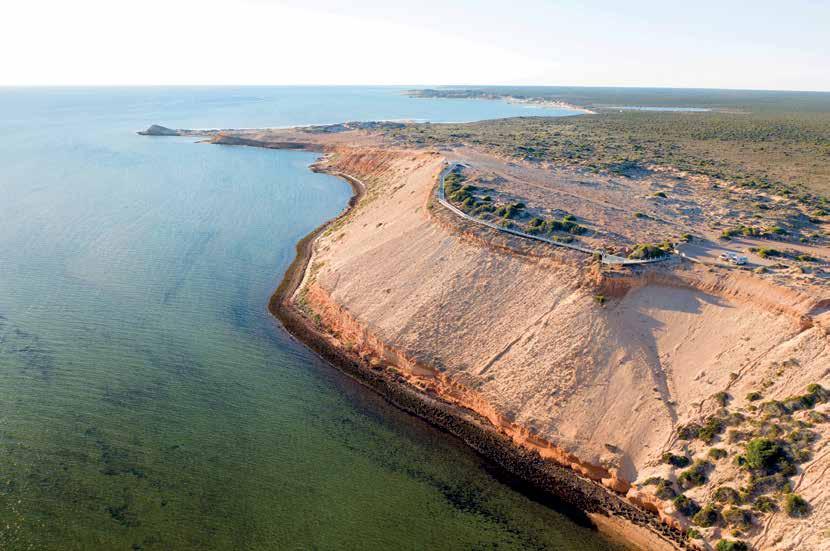
A great place to view rare marine life.
Located approximately 20km south of Denham and accessible via 2WD, Eagle Bluff features an impressively high cliff and was named after the osprey or sea eagles that nest on the rock island just offshore.
The elevated boardwalk offers beautiful views across Denham Sound and over to the Useless Loop salt pile. From the boardwalk you can see a spectacular array of Shark Bay wildlife including sharks, rays and turtles and if the timing is right, dugongs can be seen during the summer months.
For the best chance to spot marine life from the Eagle Bluff boardwalk, time your visit for when conditions are just right – ideally during high tide, with low winds and minimal sun glare.
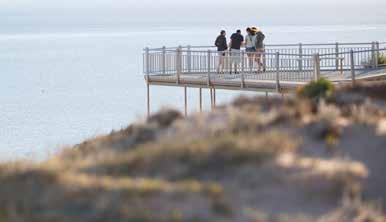

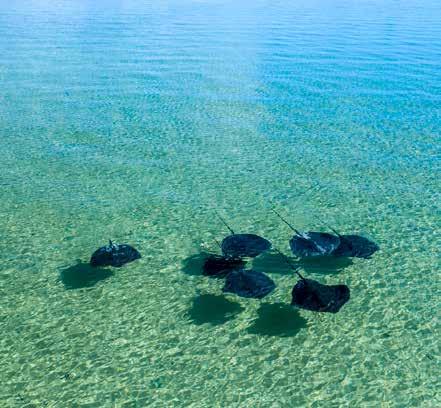
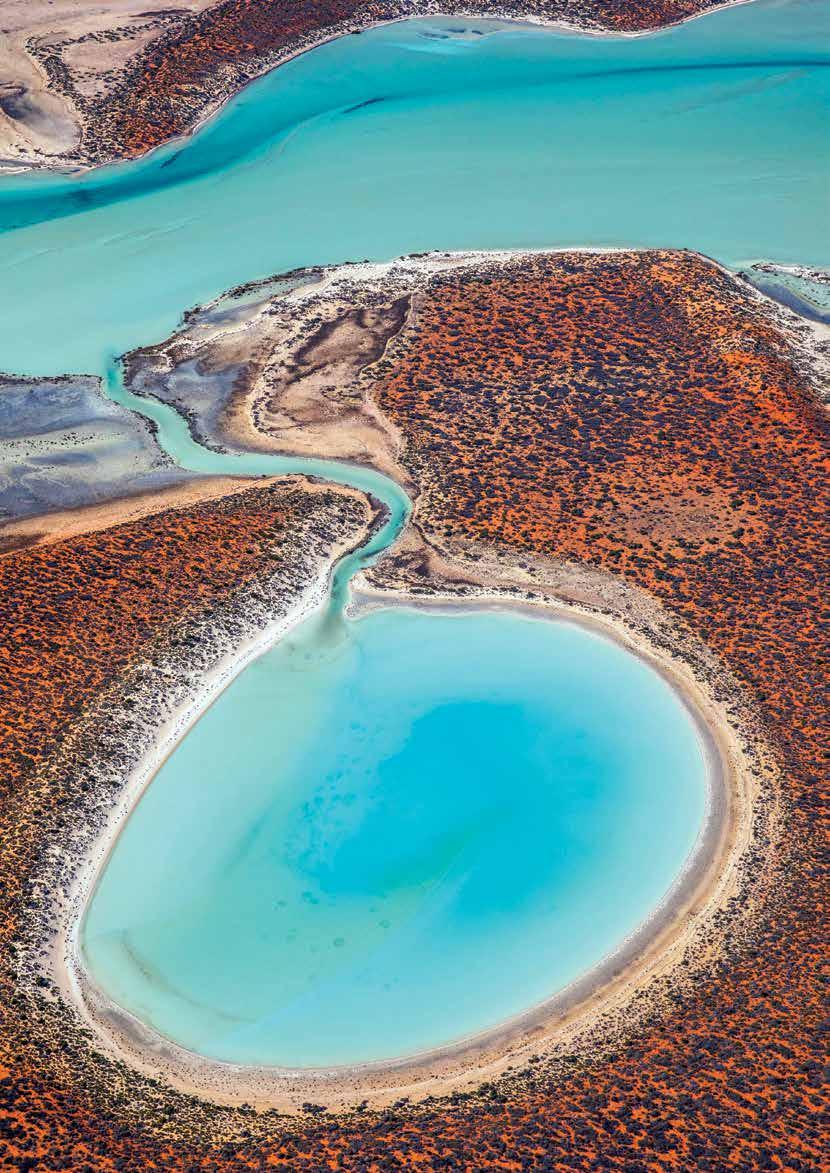
The Francois Peron National Park is where those who love the raw beauty of Australia’s wilderness can see the striking red cliffs contrasted with turquoise blue water and white sand. Swim in the pristine waters, camp under a blanket of stars, and immerse yourself in amazing nature and wildlife.
It’s hard to imagine that it was once a sheep station, and even more difficult to envisage what life would have been like in such a remote spot. You can get a taste by visiting the old Peron Homestead and shearers’ quarters. While there, take the opportunity to enjoy a dip in the artesian ‘hot tub’.
Now under the careful protection of the Department of Biodiversity, Conservation and Attractions, it is considered a precious piece of Australia, home to many rare and endangered species.
Cape Peron is the most northern tip of the Francois Peron National Park. The Cape is home to a significant colony of cormorant birds. Take the Wanamalu Trail between Cape Peron and Skipjack Point which provides excellent views of the coastline — 3km return. Picnic shelters are located at the walk’s start point. Various reptiles are often spotted here including thorny devil lizards and sand monitor goannas.
Skipjack Point has purpose built viewing platforms, perched on the cliff edge. Visitors can enjoy striking coastal views and the opportunity to view Shark Bay’s abundant marine life.
Big Lagoon is a series of magnificent tranquil lagoons. It is a perfect place to explore by kayak or paddle board where you can get up close to a rich diversity of marine life. The family friendly campground offers excellent facilities including free barbeques, sheltered decking and bar-like seating.
The 52,500-hectare park is named after a French zoologist, François Péron who accompanied an expedition there in 1801 and made some of the earliest recordings of Shark Bay’s wildlife and first people.
2WD
Homestead is unsealed and accessible by two wheel drive.
4WD
access is by high clearance four wheel drive only adding to the sense of wilderness adventure. A tyre air pressure station is located just north of the Peron Homestead for your convenience. Contact the Shark Bay World Heritage Discovery & Visitor Centre for track conditions. If you just want to sit back and relax, you can join a tour with a local expert.
The Department of Biodiversity, Conservation and Attractions (DBCA) is responsible for managing WA’s National Parks. Daily entrance fees and camping fees apply via a self-registration station at the park’s entry using cash.
When French explorers Nicholas Baudin and François Péron visited Shark Bay in 1801 there were 23 species of mammals. Less than half of them remained in 1990.
These local extinctions were due to habitat destruction and competition for food by livestock and rabbits and predation from introduced foxes and cats. Project Eden was launched to reverse this ecological destruction.
With the removal of a large proportion of feral animals from Peron Peninsula by 1997 and subsequent recovery of vegetation, Project Eden began
reintroducing wildlife to Francois Peron National Park.
Six species once found on the peninsula were reintroduced, although the only two that established viable populations were the malleefowl and bilby. While still quite rare, these species have been breeding on the peninsula for several years and are occasionally seen on roads and tracks in and near the park.
While Project Eden’s feral animal control programs continue on Peron Peninsula, a new ecological restoration program has replaced it – the Dirk Hartog Island National Park Ecological Restoration Project - Return to 1616.
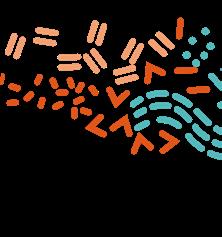
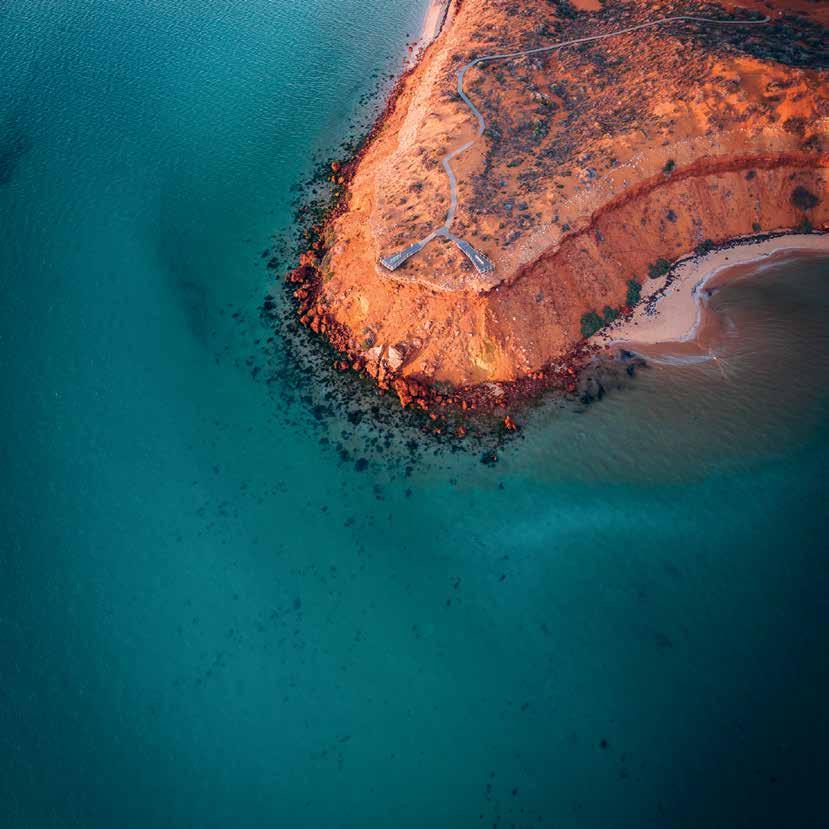
• Make sure you reduce your tyre pressure and stick to existing tracks and walkways.
• Please be sun safe and carry plenty of drinking water at all times. Temperatures can be very high in summer so be prepared.
• As there are no rubbish bins in the national park, please either take your rubbish home, or place it in the skip bins located near the air pressure station at the Homestead Precinct.
• To protect native plants and animals, open fires and pets are not allowed.
• Free gas barbecues are available at most sites and visitors may use their own gas appliances.
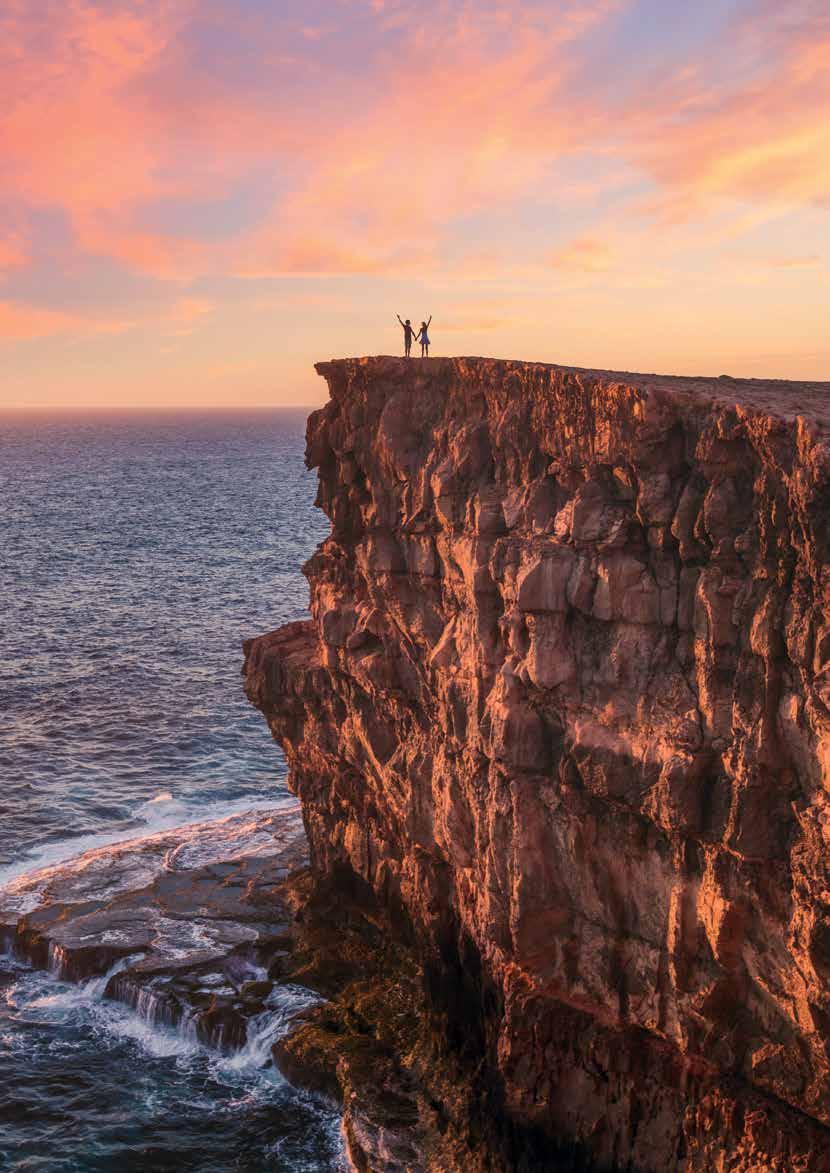
The most westerly point of mainland Australia.
Edel Land National Park offers breathtaking views of the mighty Zuytdorp cliffs, white dunes and blue seas, and is in stark contrast with the red sand dune landscapes found on the neighbouring Peron Peninsula.


In 1697, the Dutch seafarer Willem de Vlamingh named the most westerly point of the Australian mainland ‘Steyle Hock’, (‘Steep Point’ in English) when he anchored off the limestone cliffs near the southern tip of Dirk Hartog Island. Today, Edel Land is a popular wilderness camping destination, particularly as it offers some of the best shore-based game fishing in Australia.
A bucket list location for many. Take a selfie at the most westerly point of mainland Australia! Reputed to be one of the finest land based game fishing locations on the planet, experience the thrill of catching mackerel and tailor but take care in this remote and exposed area.
The Zuytdorp Cliffs are some of Australia’s least known yet most spectacular cliffs. They extend from just north of the Murchison at Kalbarri to the end of Dirk Hartog Island – a distance of more than 200km. The cliffs, rising majestically Indian Ocean to heights of up to 200m, were named after the Dutch ship the Zuytdorp, wrecked against the base of the cliffs in 1712.

Shelter Bay, a few kilometres inside the passage from Steep Point, is the most popular camping location for visitors offering beautiful beaches, good snorkelling and shelter from the prevailing winds.
Small boats can be launched directly from the beach, providing access to South Passage for fishing and diving.
Blowholes have formed from years of pounding surf which has eroded its way up through the cliffs to the surface. When large waves hit the coast, the water surges up through these holes and is forced out, sometimes with enormous power, to form a plume of seawater and mist that can be tens of metres high. Witness this phenomenon at Thunder Bay and False Entrance.

Edel Land is an extremely remote area and access is via high clearance 4WD or by boat only. Steep Point is approximately 185km by road from the Northwest Coastal Highway, including 140km of unsealed road. The last 30km is a soft single-lane track winding around sand dunes. The drive to Steep Point from Denham takes between 3 and 4 hours each way. This is serious 4WD country— caravans are not advised, but with a smaller light weight rig and proper gear, it can be done. Only attempt it if you're fully prepared and have experience towing in soft sand.
The Department of Biodiversity, Conservation and Attractions (DBCA) is responsible for managing WA’s National Parks. Daily entrance fees can be paid at the selfregistration station using cash.
Campsites must be booked in advance online parkstaybookings. dbca.wa.gov.au
For advice or information on the area contact the Steep Point Ranger on 08 9948 3993.
• Please ensure you are selfsufficient for your stay. There is no fresh water in the park.

• Please be sun safe and carry plenty of drinking water at all times, take at least 10 litres of water for each person per day. Temperatures can exceed 40°C in summer so be prepared.
• Please take all your rubbish out with you as there are no bins at Steep Point.
• To protect native plants and animals, open fires and pets are not allowed.
• Exercise extreme caution near cliff edges particularly when fishing.
Western Australia’s longest island, Dirk Hartog Island is an amazing nature-based tourism destination, renowned for tranquil beaches, stunning rugged landscapes and rich Australian history.
Stay and witness the last sunset of the Australian continent each night.
Hartog gave the Australian mainland one of its earliest known names ‘Eendrachtsland’. It was named after his ship, the Eendracht, which means ‘UNITY’.



The island was named after Dirk Hartog, a Dutch sea captain, who was the first recorded European to encounter the Western Australian coastline. Captain Hartog arrived at the northern tip of the island on 25 October 1616 leaving a pewter plate nailed to a wooden post at the site now known as Cape Inscription. At 80km long and 15km wide, the island is an ‘ark’ for endangered animal species and is an important nesting site for loggerhead sea turtles. It is also home to the endemic subspecies of the white winged fairy wren and a pied cormorant nesting colony, which has been identified as an important bird area by Birdlife International.
CAPE INSCRIPTION
The site of one of the first recorded landing of Europeans in Australia. Enjoy stunning views of the beach and the rocky headland at the most northerly point of Dirk Hartog Island National Park, a historically significant site in Australia. This remote World Heritage listed site has interpretive signage and replica plates on display from Hartog and de Vlamingh.
The Cape Inscription lighthouse, built between 1908 and 1910, is still functional and was automated in 1917. The restored lighthouse keepers’ quarters are located nearby and include interpretive panels detailing the history of the site.
Located at the island’s northern tip, Turtle Bay is a significant Australian nesting rookery for loggerhead turtles. Both low coastal and cliff walking tracks give visitors the opportunity to view some of the plentiful marine life around the island, such as manta rays, sting rays, turtles, sharks, dolphins, whales, dugongs, fish and sea snakes.
Surf Point on the southern end of the Island is a sanctuary zone, home to an amazing array of corals in clear shallow water. This site has stunning coastal scenery and offers great snorkelling and diving. Or you can go for an adventure walk on the pristine beach and spot hundreds of small sharks in the shallow waters.
The western coast of the island is a fantastic place to feel the power of the massive waves as they hit the cliffs. Where the sea has eroded the cliffs you can now visit Shark Bay’s largest blow hole. During 5m swells this blow hole can be seen 20km away and it sounds like a jet plane taking off. Join a World Heritage walk that will take your breath away!


Access via Steep Point by 4WD
A landing barge is available to transfer 4WD vehicles from Steep Point to Dirk Hartog Island. The barge carries one vehicle and a trailer at a time and takes approximately 15 minutes to cross the waters of South Passage. Bookings are essential.
Access via Denham
By Boat: Charter boats and day tours are available from Denham. Please note, tours do not depart daily so you may need to be flexible with your dates.
By Air: A light aircraft can be arranged to transfer passengers direct from Shark Bay Airport to Dirk Hartog Island airstrip. Scenic flights are another great way to see the Island.
If visiting or camping at Dirk Hartog Island National Park, please note that fees will apply.
Bring your own 4WD and camp on some of the most remote and exclusive island beaches you will find in the world. There are nine national park campsites on Dirk Hartog Island. The east coast offers seclusion, shelter from the wind, shallow entry beaches, great beach fishing, awesome snorkelling, and historical sites.
Eco Lodge
Escape the mainland and explore the island while enjoying the comforts of the Dirk Hartog Island Eco Lodge. This rustic luxury retreat with a castaway atmosphere is located right on the beach with stunning panoramic views of Shark Bay.
Please contact Dirk Hartog Island Homestead for your transfer, camping and accommodation bookings: dirkhartogisland.com or 08 9948 1211.
Please scan this QR code to help prepare for your next trip to Dirk Hartog Island.

A local restaurant in Denham, the Old Pearler is the only restaurant in the world to be built almost entirely of shells!
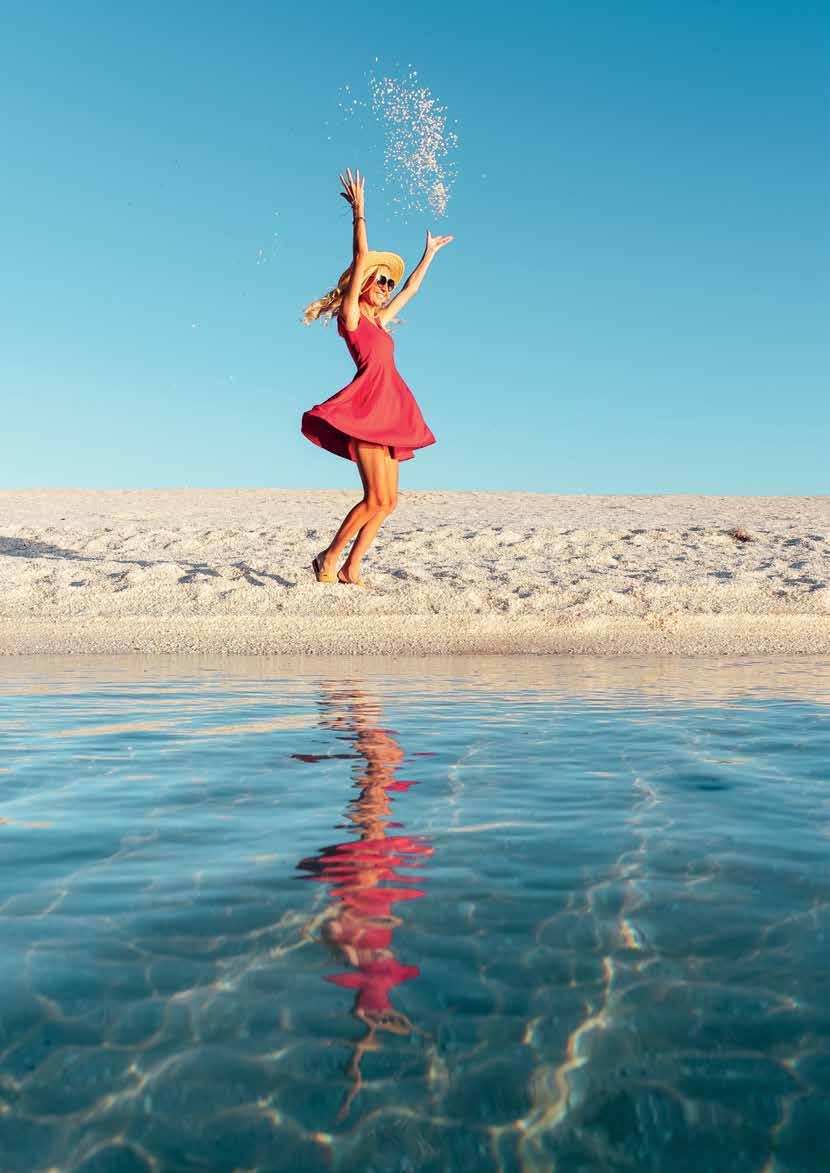
This beautiful snow-white beach is made up of millions of tiny shells up to 10m deep and stretching for over 60km.
Shell Beach is one of only a handful of places on earth where shells replace beach sand in such a dramatic and picturesque way. The beach is made up of shells from the Hamelin Cockle, making it truly unique.
In years gone by the shells were hard packed, cut into blocks and used to construct a number of historic buildings in the nearby town of Denham. Visit the Old Pearler Restaurant or the St Andrews Anglican Church to see examples of these shell brick constructions, or follow The Denham Discovery Trail, a 2.3km walking trail that will take you past sites of interest.
Shell Beach is easily accessible by 2WD from the Shark Bay Road and is located 50km south of Denham. The attraction is free of charge, facilities include toilets and a car park with a turning circle for larger caravans.

People have gathered in Shark Bay for many generations; Malgana, Nhanda and Yinggarda people, Dutch traders, French naturalists, English explorers, local pearlers, pastoralists, fishers and conservationists have layered the land with cultural diversity. When people inhabit an environment they create a cultural landscape. They leave traces, for days or millennia. The area is rich in history, and strewn with relics such as ship wrecks, pastoral stations, abandoned camps and ancient artefacts. Descendants of these people still live in the area and actively strive to preserve their history.
Shark Bay World Heritage Discovery & Visitor Centre
Visitor centre, museum and art gallery 53 Knight Terrace, Denham 08 9948 1590 sharkbayvisit.com.au
Visit the World Heritage Discovery Centre to learn about the significance and history of the Shark Bay Region. The Discovery Centre has fascinating displays including historical and contemporary film footage, interactive multimedia and objects of rare scientific and historical importance.
Visit the HMAS Sydney II memorial and the Fire on the Water exhibition. The 15 minute 3D film and accompanying exhibit tell the story of the battle between HMAS Sydney II and HSK Kormoran,
tracing the events of this World War II Naval battle 200km off the coast of Shark Bay. Astonishing deep-sea 3D imagery from the 2015 expeditions to the wreck sites have been used to create an interpretative timeline of the battle and to offer insights into what happened when the ships met off Shark Bay in 1941.
The exhibit is permanent, free and screens every half hour during the Shark Bay World Heritage Discovery & Visitor Centre’s opening hours. To learn more about this tragic story you can also visit the Museum of Geraldton.
Talk to the local experts about tours, accommodation and general information regarding Shark Bay. Their knowledge can help you to plan your visit and make the most of your time here.




Denham’s streets were once paved with pearl shells!

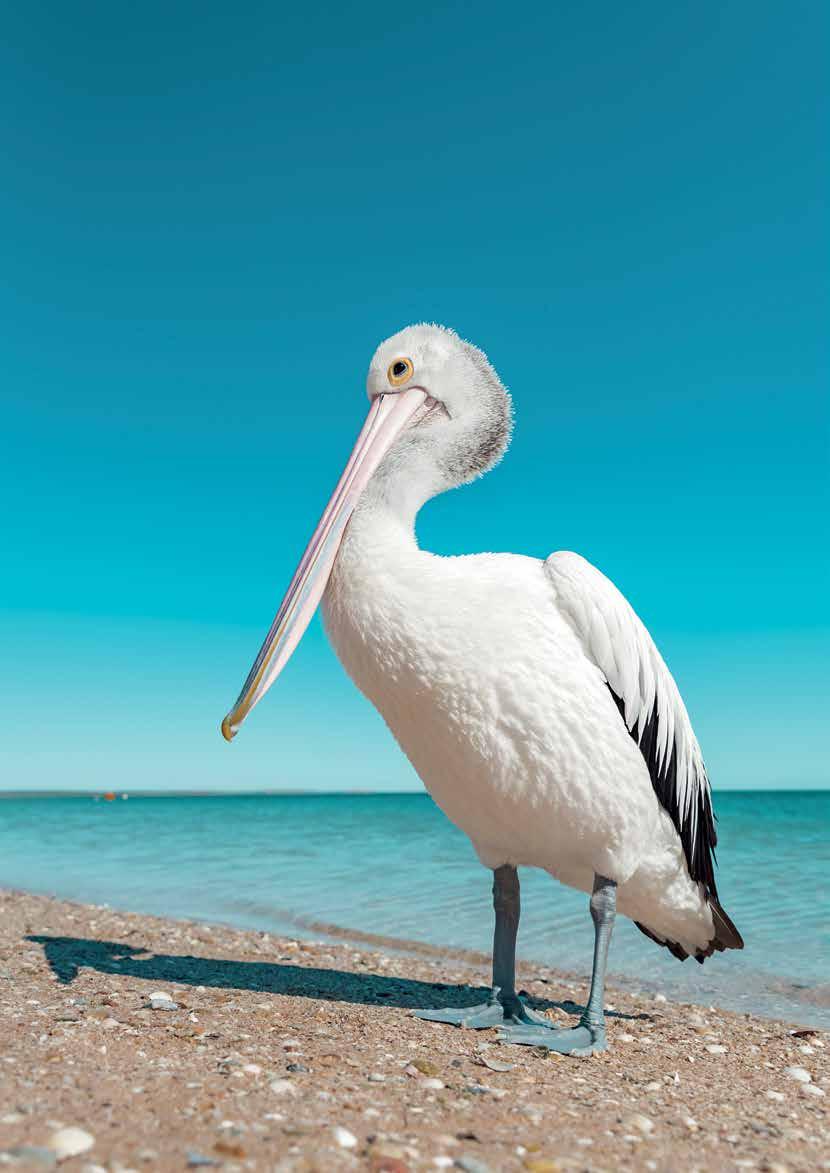
If you love wildlife, you will love Shark Bay.


BY SEA
From the deepest navy blue to the brightest, clearest turquoise and absolutely teeming with marine life, Shark Bay’s crystal clear waters offer the chance to experience once-in-a-lifetime wildlife encounters.
Humpback whales visit Shark Bay in between August and October. The whales migrate up the coast to their calving grounds in the Kimberley and then return with their calves to the calm protected waters of Shark Bay.
Australian pelicans are large black and white birds with an enormous bill and bright yellow eyes. These beautiful birds can be found regularly at Monkey Mia, often trying to steal fish from the dolphins!
There are at least 28 shark species in Shark Bay. The most impressive is the Tiger shark or “thaaka” in Malgana language. The most common to spot is the Nervous shark, a small shark that gets its name due to its timid nature. Shark Bay is a perfectly safe place to swim and enjoy the beautiful turquoise waters.
Dugongs can be seen during the summer months The best place to see these endangered mammals is on a wildlife watching cruise or if you’re lucky, from Eagle Bluff or Skipjack Point in the Francois Peron National Park.
Rays are closely related to sharks, there are six common species of ray in Shark Bay. You’ll spot graceful manta rays and eagle rays gliding through the water. The

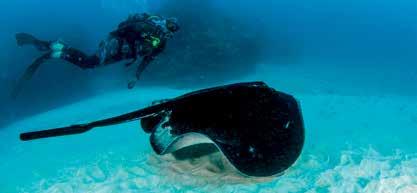
shovel-nose ray is a common sighting in the shallow sandy bays of the region. More than 6,000 turtles live in Shark Bay, the green and loggerhead turtles are endangered, however you’re still likely to spot them in Shark Bay.
BY LAND
The Shark Bay World Heritage region is a mecca for visitors interested in discovering unique and diverse wildlife. The Thorny Devil is common but hard to spot, and is a favourite for locals and visitors alike.
Echidnas belong to a group of mammals called monotremes (egg-laying mammals). With a keen sense of smell, they snuffle around looking for ants and termites to eat.
Emus are a common sight in Shark Bay – you’ll spot them strolling around the bush, looking after their chicks and on a hot day taking a dip in the ocean!
Galahs are members of the cockatoo family and are easily identified by their rose-pink heads, necks and underpants. Shy, nocturnal creatures, bilbies are not a common sight for the average visitor. In appearance they are similar to a rabbit, with long pink ears and silky, grey fur.

Emus do things differently; dad rather than mum sits on the nest and cares for the chicks for 18 months after they are hatched.

The longest wildflower season in WA!
Shark Bay is one of the most diverse botanical areas in Western Australia. More than 700 flowering plant species have been recorded here, more than 150 species are of special scientific interest and several are exclusive to this unique area.
Depending on rainfall, the best display of wildflowers in Shark Bay can be seen between July and September. Some of the most outstanding and abundant species include:
• Shark Bay daisy (Brachyscome latisquamea)
• Shark Bay mallee (Eucalyptus roycei)
• Tamala rose (Diplolaena grandiflora)
• Dune wattle (Acacia ligulata)
• Everlastings (Schoenia cassiniana)
• Feather flower (Verticordia cooloomia)
• Halgania (Halgania littoralis)
• Scarlet runner (Kennedia prostrata)
WORLD HERITAGE DRIVE
Carpets of yellow and white everlastings will welcome you on your drive into Shark Bay as you turn off the North West Coastal Highway.
NICHOLSON POINT
To see specimens of Shark Bay daisy and Tamala rose we suggest a visit to Nicholson Point in Denham – you’ll smell the fragrant air as you approach.

SOUTHERN NANGA BAY AND EASTERN TAMALA
If you are searching for the Shark Bay mallee, this can be found in the Tree Heath which is located at Southern Nanga Bay and Eastern Tamala.
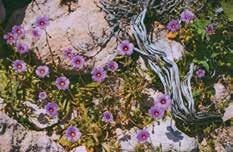
NATIONAL PARKS

Explore Shark Bay's pristine National Parks for a treasure of wildflowers: Francois Peron National Park, Dirk Hartog Island National Park, and Edel Land National Park.


Enjoy our free Art Gallery & 'Fire on the Water' 3D Film.
Browse our Gift Store to find something to remind you of your stay. Collect maps and directions or use our free booking services for accommodation and tours. Come in and meet our friendly Staff who can help with Itinerary planning, local knowledge and local insights.






By Road
Denham is 840km north of Perth via the Northwest Coastal Highway, approximately a 9 hour drive. Turn at the Overlander Roadhouse which will take you onto the World Heritage Drive and the beginning of your Shark Bay experience, affectionately known by locals as "the driveway".
By Coach
Integrity Coachlines offer services from Perth and Broome. The Overlander Roadhouse is the stop for Shark Bay. Bookings can be made at the Shark Bay World Heritage Discovery & Visitor Centre, online at integritycoachlines. com.au or phone 08 9274 7464.
From the Overlander Roadhouse, a shuttle to Shark Bay must be pre-booked to Denham or Monkey Mia with Integrity Coachlines.
By Air
Regional Express Airlines operates return flights from Perth to Monkey Mia/Shark Bay Airport, approximately 7km from Denham. Bookings can be made at the Shark Bay World Heritage Discovery & Visitor Centre or online at rex.com.au
Need transport when you arrive? Hire a car and pick it up at the Airport. For visitors staying at RAC Monkey Mia Resort, a shuttle can be organised directly with your accommodation provider.
A free sewage waste dump point is located in the information bay on the Shark Bay Road as you approach Denham. For a small fee, potable water is available from the Information Bay on Shark Bay Road.
Please note, there is no free camping in the Shark Bay World Heritage Area. Campers are encouraged to contact the numerous caravan parks in the Shark Bay area offering powered and unpowered sites. Always book ahead.
Campsites at Eagle Bluff, Whalebone Bay, Fowlers Camp and Goulett Buff lie within the area commonly known as South Peron which is now designated Class A National Park. Bookings are available at: parkstay.dbca.wa.gov.au
Contact the Shark Bay World Heritage Discovery & Visitor Centre for further information and to make a booking. Campers must stay in a designated
Shark Bay has many beaches suitable for dog exercise. There are also lots of dog friendly businesses that will gladly welcome your furry friend. Dogs are not permitted in the National Parks, however they are permitted on lead into Monkey Mia. A 1080 poison baiting program is underway to control feral cats and foxes, this poison does not harm native wildlife but is lethal to dogs and cats.
Dog owners should be aware that sea hares are commonly found on beaches in the Shark Bay area. These can be toxic to dogs if ingested.
Please see the 'Pet Owners Beware' flyer for more information at: sharkbay.org/ advice/travel-safety/pets
Contact Shark Bay World Heritage Discovery & Visitor Centre for further information including contact numbers for local dog sitters.
The Coral Coast Highway between


HANDY CONTACT DETAILS
Emergency 000
Shark Bay World
Heritage Discovery & Visitor Centre 08 9948 1590
Police Station 08 9948 1201
Shark Bay
Health Centre 08 9948 1400
Volunteer Marine Rescue 08 9948 1376
Steep Point Ranger 08 9948 3993
Parks & Wildlife Service 08 9948 2226
Shire of Shark Bay 08 9948 1218
Only Telstra and Optus mobile phone networks have extensive coverage in the Shark Bay region, however in some remote areas coverage cannot be guaranteed. Please check with your provider for full details on mobile coverage.
Free internet access is available at the Shark Bay World Heritage Discovery & Visitor Centre. The Shark Bay Community Resource Centre offers free internet access and other computer services for a small fee.
Many other locations in Shark Bay also offer WIFI to paying customers.
Shark Bay World Heritage Discovery & Visitor Centre
53 Knight Terrace, Denham 08 9948 1590 sharkbayvisit.com.au
ATMs are available at the Shark Bay Supermarket, and RAC Monkey Mia Dolphin Resort. There are no banks in Shark Bay, however the Shark Bay Post Office located at 51 Knight Terrace offers banking services during business hours.

DECEMBER, JANUARY, FEBRUARY
Warm and windy! A perfect time to embrace the wind by kitesurfing or windsurfing, or cool down with a refreshing swim in the shallow bays. Be prepared for warmer temperatures averaging between 30-35ºC.
MARCH, APRIL, MAY
Calm balmy days and breathtaking sunsets make autumn a great time for a family holiday. With low wind and tranquil seas, it's a popular time for fishing with the annual Shark Bay Fiesta competition taking place in May.
JUNE, JULY, AUGUST
Cooler weather and sunny days make perfect conditions for hiking, bushwalks, camping, kayaking and paddle boarding. Towards the end of winter is the best time of year to view the stunning wildflowers.
SEPTEMBER, OCTOBER, NOVEMBER
A quieter time of year, good for solitude seekers who enjoy wilderness. Humpback whales frolic in Shark Bay and the underwater world comes alive with marine life making spring the best time to dive and snorkel.
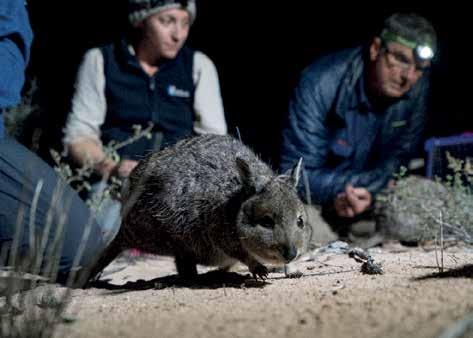
The Department of Biodiversity, Conservation and Attractions Return to 1616 Ecological Restoration Project is helping to restore Dirk Hartog Island’s ecosystem to a condition resembling that seen 400 years ago. As a result of this project, the island is now the largest in the world to have been made free of feral cats, goats and sheep.
With the removal of feral animals, the island has been made safe for the return of locally extinct threatened mammal and bird species. As of June 2025, seven locally extinct species have been returned to the island — the dibbler, Shark Bay bandicoot, brush-tailed mulgara, Shark Bay mouse, greater stick-nest rat, western grasswren and woylie. In addition, two species have been translocated for conservation purposes (rufous hare-wallaby and banded hare-wallaby). There are early indications that these species are all establishing on the island and preparations are underway to release two more species, the boodie and chuditch.


To protect the native animals re-establishing on the island, it’s crucial to keep out introduced animals and plants. You can support restoration efforts by following these guidelines.



Pack for your trip with care
• Don’t bring any animals including pets to the island.
• Remove insects, soil, seeds, spiders, and other animals from your camping gear, footwear and clothes.
• Don’t bring firewood to the island.
• Pack equipment for a final vehicle clean at the barge site.
• Pack food in clean, sealed, plastic or metal containers instead of cardboard which can harbour pests.
• Ensure fresh food is free of soil, insects, and snails.
While on the island
Take care to avoid native animals at all times when driving on the island. Please note:
• Animals often use vehicle tracks to move from place to place.
• Native mammals are most active from dusk to dawn. Please take extra care when driving between these times.
Hartog island National park





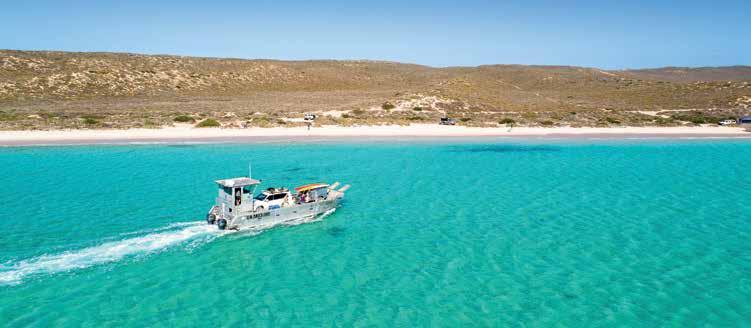



Big fish or family fun – we’ve got you covered!
Whether you’re chasing snapper at Steep Point or dolphin spotting with the kids in Monkey Mia, our hire boats are ready for your adventure.
• Target coral trout, snapper, mackerel & more
• Explore sheltered bays, beaches & marine life hotspots
• Safe, fully equipped vessels | Local tips included
• Launch from Denham, Monkey Mia, or tow remote

Book online now and make it a trip to remember!
0487 421 690 monkeymiaboathire.com
Based in Denham –Servicing all of Shark Bay #BigFishBigAdventure Scan to book instantly!

0447 005 088 tidelineboathire @gmail.com




LOCAL ARTS, JEWELLERY AND CLOTHING HANDCRAFTED IN SHARK BAY
Shark Bay Hotel, 43 Knight Terrace, Denham Open Monday-Saturday 10am-2pm E Q



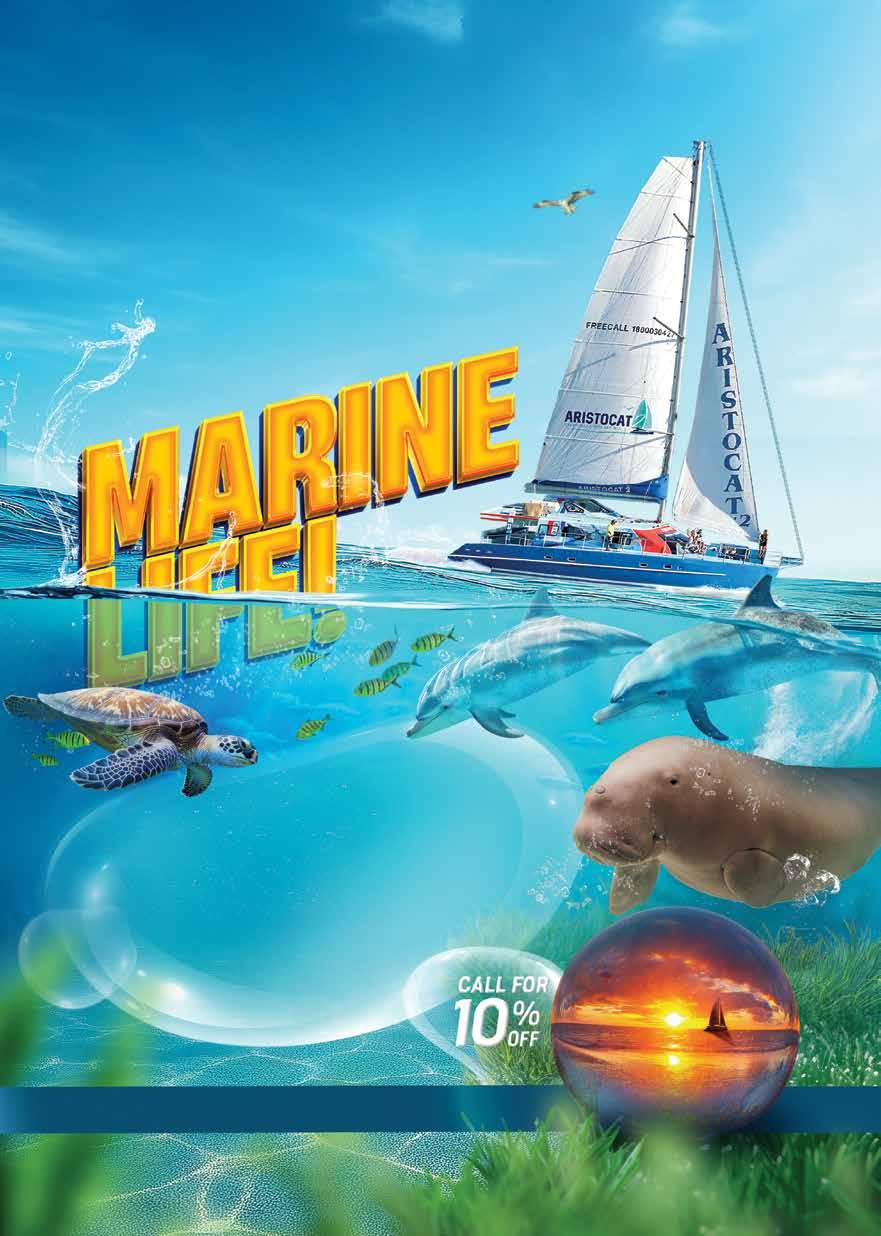



Book your flight today and let the magic of Shark Bay take your breath away!





Fly from Shark Bay to Dirk Hartog Island, Useless Loop, Zuytdorp Cliffs and Steep Point with your own window seat!


Powered by



Book your adventure today!
Soar above the coastal magic of Shark Bay
Welcome to Shark Bay Scenic Flights, your ticket to an awe-inspiring aerial adventure over one of Western Australia’s most unique regions.
From vibrant salt ponds to winding coastlines and crystal-clear waters, Shark Bay offers a spectacular landscape that’s best appreciated from above.
Let us take you on an unforgettable journey through the skies over this extraordinary slice of Western Australia.
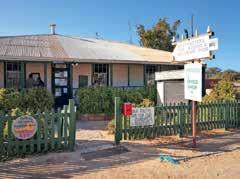
Best price in the area! Unpowered from $20pp. Backpackers from $40pp. Ensuite rooms $150 for max. 2 people. Family rooms from $150. Hamelin Pool Road (5km to the end of the sealed road) GPS 26.401403 South / 114.165838 East 08 9942 5905 0401 833 040 patriciacox27@westnet.com.au


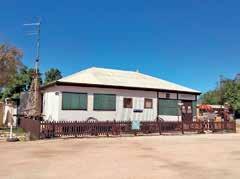
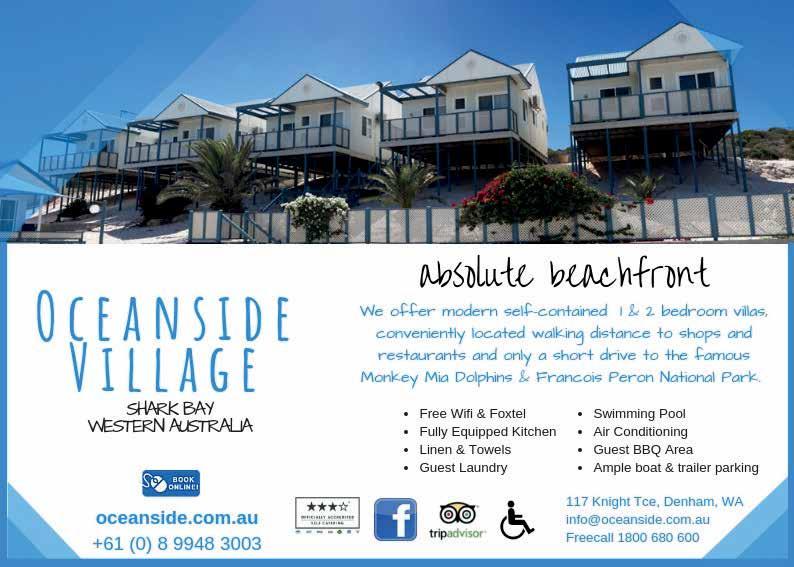
• Swimming Pool • Air Conditioning • Guest BBQ Area • Ample boat & trailer parking




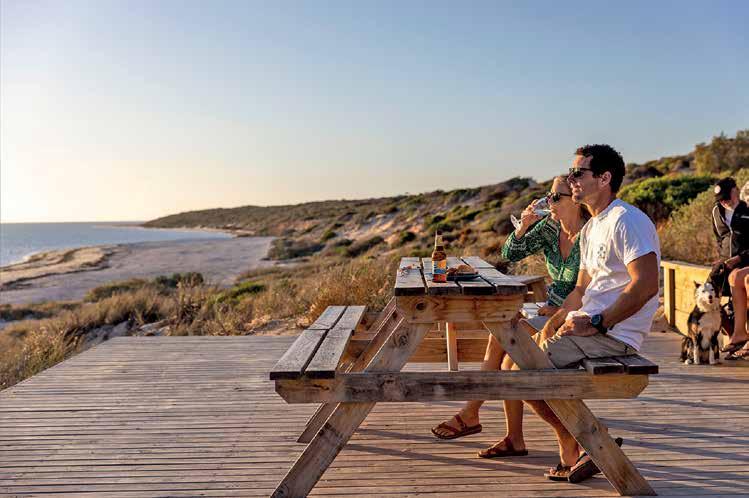













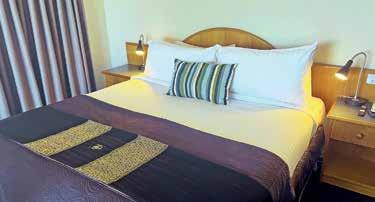








(6kms
















Truly the community’s pub. Come and have a drink with the locals! BAR

Happy Hour
4.30pm-5.30pm Every day (except Friday)

Open from 10am
Open daily from 10am RESTAURANT
Open every day
Lunch 12pm - 2pm Dinner 5.30pm - 8.30pm
Come in for a coldie, a yarn, or just some good old-fashioned ‘Oldie’ hospitality


43 Knight Terrace, Denham, WA 6537
(08) 9948 1203
enquiries@sharkbayhotelwa.com.au sharkbayhotelwa.com.au E Q
Located on the beautiful foreshore of Denham, you couldn’t find a more pleasant place to simply relax, enjoy a nice cold drink, a snack, or one of the many highly praised meals on our menu.

The perfect location to explore the Shark Bay and Monkey Mia region
Clean and comfortable budget accommodation
12 rooms available
Ensuite bathroom • Air-conditioning Refrigerator • Tea and coffee making facilities Television • Fresh sheets & towels



43 Knight Terrace, Denham, WA 6537
(08) 9948 1203
enquiries@sharkbayhotelwa.com.au sharkbayhotelwa.com.au E Q


